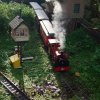G-force1
Prevarication Rules!
Depth of Field. No it's nothing to do with how far your wellies will sink into the countryside, but I've found it is something folks have a little problem with understanding, so here's a short explanation. It can be useful, or a b. nuisance, though often in model photography the former, as it can be used to 'fade out' backgrounds etc. and make stuff not meant to be in the picture less prominent.
I thought this a good example.

The loco at the front is nice and sharply in focus but by the time you get back to the second waggon, there's a bit of fuzz about, which gets stronger to the rear of the train. It's going further and further 'Out of Focus'. Look carefully at the very front of the photo and that too is going out of focus, the sleepers (ties) are getting progressively fuzzier towards the front of the picture. The bit that is acceptably in focus is called the 'Depth of Field'. There are several things can affect the amount of D.o.F available. How close the object is to the lens, the closer the more obvious the effect is, much less when further away. What setting the lens is on or the amount of light available. I'd suggest it's something that can be experimented with to good effect.
I thought this a good example.

The loco at the front is nice and sharply in focus but by the time you get back to the second waggon, there's a bit of fuzz about, which gets stronger to the rear of the train. It's going further and further 'Out of Focus'. Look carefully at the very front of the photo and that too is going out of focus, the sleepers (ties) are getting progressively fuzzier towards the front of the picture. The bit that is acceptably in focus is called the 'Depth of Field'. There are several things can affect the amount of D.o.F available. How close the object is to the lens, the closer the more obvious the effect is, much less when further away. What setting the lens is on or the amount of light available. I'd suggest it's something that can be experimented with to good effect.


















